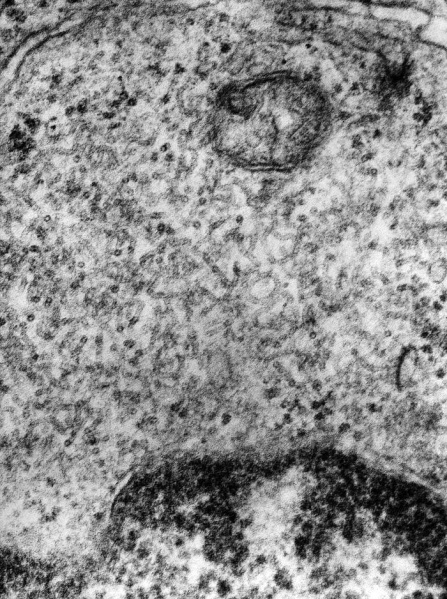File:Mumps virus.jpg

Original file (700 × 938 pixels, file size: 221 KB, MIME type: image/jpeg)
Mumps virus
This transmission electron micrograph (TEM) revealed the presence of numerous paramyxovirus virions, which in this instance, were responsible for a case of the mumps. Paramyxoviruses are members of the family, Paramyxoviridae, and those that cause mumps in humans belong to the genus, Rubulavirus. The virus itself can present itself in a number of morphologic shapes, including spherical, and stand-like, or filamentous, ranging from 150nm to 200nm in diameter, and 1000nm to 10000nm in length. At its core lies a non-segmented, negative-sense RNA genome.
Mumps is a viral illness characterized by swelling of the salivary glands, known as “parotitis”. The incubation period from exposure to onset of symptoms is generally 16 - 18 days, but can range from 12 to 25 days. Transmission is by respiratory droplets, saliva or contact with contaminated fomites. Patients are usually contagious from 1 to 2 days, but occasionally as long as 7 days, before symptom onset, until 9 days after the onset of symptoms.
Content Providers(s): CDC/ Dr. Fred Murphy Creation Date: 1975
Copyright Restrictions: None - This image is in the public domain and thus free of any copyright restrictions. As a matter of courtesy we request that the content provider be credited and notified in any public or private usage of this image.
10200_lores.jpg
File history
Click on a date/time to view the file as it appeared at that time.
| Date/Time | Thumbnail | Dimensions | User | Comment | |
|---|---|---|---|---|---|
| current | 11:50, 7 November 2011 |  | 700 × 938 (221 KB) | S8600021 (talk | contribs) | ==Mumps virus== This transmission electron micrograph (TEM) revealed the presence of numerous paramyxovirus virions, which in this instance, were responsible for a case of the mumps. Paramyxoviruses are members of the family, Paramyxoviridae, and those t |
You cannot overwrite this file.
File usage
The following page uses this file: